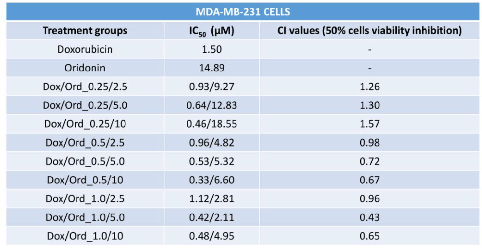| 109P London, UK Pharmacology 2017 |
Synergistic effects of doxorubicin and ordonin on suppressing cancer growth via pro-apoptotic and anti-angiogenic pathways
Introduction: Doxorubicin (Dox) is a drug used in the treatment of various cancers such as breast cancer and ovarian cancer. However, the dose-dependent cardiotoxicity of doxorubicin limits its therapeutic use1. Combination of Dox with another agent which has synergistic anti-cancer effect should be beneficial since it can lower the dose requirement and hence the cardiotoxic side effects of doxorubicin. Ordonin (Ord) is the major bioactive component in Rabdosia rubescens. It possesses various pharmacological activities including anti-cancer and anti-angiogenic2 effects. However, its low bioavailability and limited efficacy pose difficulties for developing it as a therapeutic agent alone. The aim of this study was to investigate the anti-cancer effect of the combination of Dox with Ord.
Method: MDA-MB-231 cancer cells were treated with Dox (0.06 to 5 μM), Ord (0.03 to 40 μM) or different combinations of Dox (0.25 to 1 μM) and Ord (2.5 to 10 μM). After 48 h incubation, cell viability was assessed with MTT assays. The synergism of Dox and Ord co-treatment was evaluated by calculating the combination index (CI) based on the additive effect of the two drug-effect equation by median-effect analysis3. Moreover, combinations of Dox (0.25 to 1 μM) and Ord (1.25 to 5 μM) at a molar ratio of 1:5 were tested in Human umbilical vein endothelial cells (HUVECs) for investigating their synergistic effects on inhibiting endothelial cell proliferation, migration, invasion and tube formation.
Results: Ord (5 and 10 μM) synergistically enhanced the pro-apoptotic effect of Dox (0.5 and 1 μM) on MDA-MB-231 cancer cells. The CI values of each combination were shown in Table 1. In addition, Dox synergistically potentiated the anti-angiogenic effect of Ord, probably through the inhibition of proliferation, migration, invasion, and tube formation of endothelial cells.

Table 1. Cytotoxicity of different combinations of Dox and Ord against MDA-MB-231 cells.
Conclusions: The combination of Dox and Ord may provide a promising strategy for inhibiting cancer growth in a synergistic manner via pro-apoptotic and anti-angiogenic pathways. Further study is warranted since Ord may lower the dose requirement and hence the side effects of doxorubicin in cancer therapy.
References:
1. Sawyer DB. (2013) New Engl J Med 368: 1154-1156.
2. Dong Y et al. (2014) Plos One 9(12).
3. Zhang N et al. (2016) Am J Cancer Res 6: 97-104.

